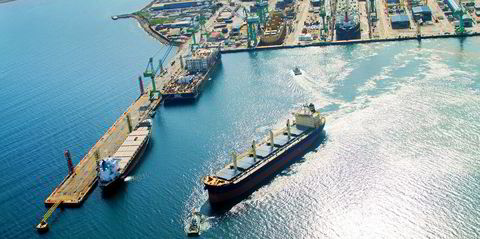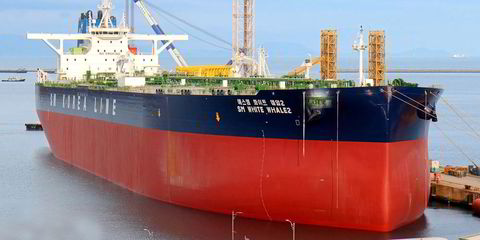As another earnings season rolls out for dry bulk shipowners, public-company management teams will have a chance to persuade investors that they should be treated better than shipping’s version of Rodney Dangerfield.
This is to say that, as in the stock line of the US comedian, they “don’t get no respect”.
As a group, listed dry bulk owners were trading at an average of 84% of their net asset values, according to a research note this week from Clarksons Securities. This is compared with 94% for counterparts who own crude tankers and 95% for those who operate clean product carriers.
Maybe this is a step up, as this time last year the public dry guys were at 63% of NAV, although by an estimate of a different investment bank — Jefferies.
In any case, the discount has prevailed for years. And while not everyone would agree it’s a sign of investor disrespect for public company management teams … well, we have to guess some executives get that “Rodney” feeling from time to time.
Maybe investors should take into account the annual findings of Danish researchers Anders Liengaard and Soren Roschmann in their annual VesselIndex Report, shared exclusively with Streetwise.
It shows that the 23 listed owners are in large part beating the relevant Baltic Exchange indices for their vessel types, and the outperformance keeps improving year over year.
All told, 18 of the 23 produced earnings that beat the market by an average of 18.7%, with half of the outperformers doing so by double digits.
This follows an average outperformance of 11% in 2022, an underperformance of 17% in 2021, and beats of 7.5%, 6.4% and 4.4% in the three preceding years.
“This achievement, while not unexpected, aligns with our previous explanation of how it’s seemingly easier to sustain higher earnings during market downturns compared to upswings,” Liengaard and Roschmann wrote.
“This is attributed to the time lag of fixed earnings versus the immediate impact of movements in spot rates.”
Shift from exceptional to normalised markets
This is not to say that 2023 was a tough year for bulker owners. It is more that it followed two years of excellent markets in 2022 and 2021. The researchers cite “more normalised” time charter equivalent levels overall.
“The Panama Canal drought, persisting throughout the year, contributed to rates staying within the five-digit territory,” they wrote, meaning at least $10,000 per day.
“Another big event, the Houthis attacks on commercial ships in the Red Sea, only started late 2023 and is likely to influence the results of next year’s report more than the results of this year’s report.
“In 2023, the market remained relatively stable overall, with minimal fluctuations except for a significant spike in capesize rates toward the end of November and early December.”
Without the spike in rates above $50,000 per day, capesizes would have earned 12% less on the year. The brief duration of the rally explains why capesize owners did not outperform the market to the same extent as owners in other segments, the researchers said.
Also, owners who took cover during the better market in 2022 tended to fare better in 2023 as spot rates normalised, they said.
That is not necessarily what sparked the owner that topped the Liengaard and Roschmann tables for the second consecutive year, however.
Klaveness Combination Carriers prevailed again on the strength of operating … well, combination carriers.
In what again will provoke some “apples and oranges” bellyaching, Klaveness was able to exploit operating a significant part of its fleet in the stronger tanker market, leading to an outperformance of nearly $24,000 a day, or 218%.
Klaveness fleet versatility driving record rates
While one-half of Klaveness’ 16-strong fleet carries only dry bulk cargoes, the other half is capable of carrying either wet or dry loads. In the first quarter of 2024, for example, 75% of the versatile fleet operated as tankers, driving record rates.
Streetwise questioned Klaveness’ inclusion last year, but the researchers find the situation to be similar to including perennial outperformer Pangaea Logistics Solutions, whose fleet includes ice-class bulkers. Like the combo carriers, they are pricier and earn a premium, albeit purely in dry bulk.
For those who like their bulker fleets composed purely of bulkers, perhaps your winner is Belships of Norway, which finished a distant second with a $5,703 premium, or 46.2%.

Rounding out the top five were three names frequently seen near the peak. Thoresen Thai Agencies came third at $3,790, or 38.6%, followed by Pangaea at $4,337, or 37.7%, and Pacific Basin Shipping at $2,795, or 26.4%.
Just missing the top five were two of the bigger New York-listed owners: charter-happy Diana Shipping at $3,098, or 22.8%, and fellow Greek owner SafeBulkers at $2,670, or 19.2%.
In a year when only five owners underperformed the market, the bottom five was an especially painful place to be.
Names in the red
Bringing up the rear was Jinhui Shipping, which earned $3,325, or 27.9%, below market indices. Second-worst was OceanPal, the New York-listed owner spun off by Diana, at minus $1,398, or 12.3%.
Rounding out the laggards were Greece’s Globus Maritime at minus $997, or 9.7%, Oslo-listed 2020 Bulkers at minus $1,446, or 5.8%, and then a bit of a shocker in New York-listed goliath Star Bulk Carriers, which just missed black numbers with a $143 deficit, or 0.9%.
As Liengaard and Roschmann noted once again this year, just about anyone can have a bad year — and the same applies to a good one — but there is now mounting data that shows the performers and non-performers going back to 2018.
Not surprisingly, Klaveness and Pangaea have come first and second over the years, partly owing to the tonnage advantages previously discussed.
But those two names aside, Thoresen and Pacific Basin are next and are the only two outfits with standard tonnage to outperform the market by more than $1,000 a day over that time.
The laggards list for the same period, from worst: Uni-Asia Shipping, Globus, Malaysian Bulk Carriers, Jinhui and GoodBulk, which during the course of 2023 sold the last of its ships and, therefore, was not ranked in the annual table.
More ship finance news
Clarksons faces another shareholder revolt on pay this week as proxy firms recommend voting down the London-listed shipbroker’s remuneration policy. Click here to read.
Singapore giant BW Group is splitting off oil exploration and production company BW Energy from its shipping businesses. Click here to read.
Spot rates for LNG carriers are expected to see their seasonal summer uplift after a spring slump, but two financial analysts prepped their clients for a more modest rebound than in previous years.Click here to read.







